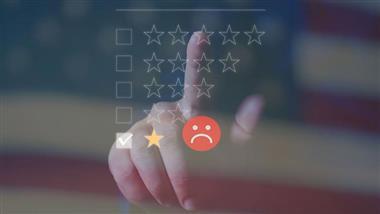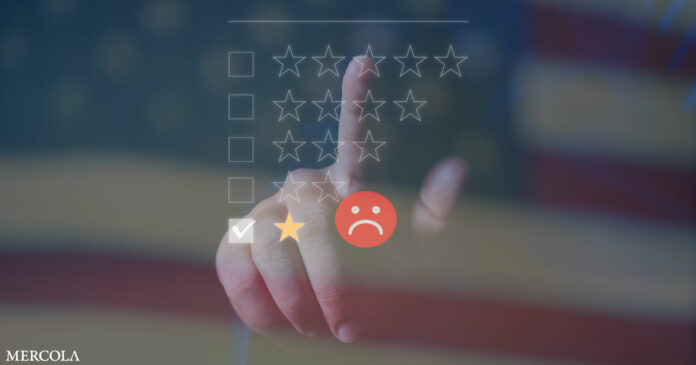
Story at-a-glance
- Only 39% of U.S. adults reported having “a great deal of confidence” in the scientific community, which means 61% did not
- Fewer adults had faith in science in 2022 compared to 2021 and 2018, when 48% reported feeling a great deal of confidence about science
- The 2022 results also revealed that 48% of U.S. adults had “only some” confidence in science, while 13% had “hardly any”
- Americans also reported “lower levels of trust in education, the press, major companies and organized religion”
- The findings come from the General Social Survey, which has been conducted by the Associated Press-NORC Center for Public Affairs Research at the University of Chicago since 1972
Science became a buzzword during the COVID-19 pandemic. “Follow the science,” we were told. “Trust the science.”1 But most U.S. adults aren’t falling for it. Only 39% of U.S. adults reported having “a great deal of confidence” in the scientific community,2 which means 61% did not.
The finding comes from the General Social Survey, which has been conducted by the Associated Press-NORC Center for Public Affairs Research at the University of Chicago since 1972. Fewer adults had faith in science in 2022 compared to 2021 and 2018, when 48% reported feeling a great deal of confidence about science.
The 2022 results also revealed that 48% of U.S. adults had “only some” confidence in science, while 13% had “hardly any.”3
Politics Play Role in Attitudes About Science
The General Social Survey for 2022 surveyed 3,544 U.S. adults from May 5, 2022, to December 20, 2022. While politics are best left out of scientific research, the survey found a partisan divide in terms of views about science and medicine.
“It doesn’t look all that dramatic when you just look at the trends for the overall public,” Jennifer Benz, deputy director of the Associated Press-NORC Center for Public Affairs Research. “But when you dig into that by people’s political affiliations, there’s a really stark downturn and polarization.”4
While 53% of Democrats said they had high confidence in science, only 26% of Republicans said the same. Still, drops in trust were seen among both political parties, with trust in science declining to pre-pandemic levels among Democrats and falling even farther for Republicans.5
Trust in medicine also fell, with only 26% of Republicans and 42% of Democrats reporting high confidence in the field. Americans are also losing confidence in other institutions. The AP reported:6
“For Sudip Parikh, CEO of the American Association for the Advancement of Science, the drops were “disappointing but not surprising.” He sees them as part of an “overall pulling apart of our communities” and a loss of trust in many institutions.
The latest survey found that distrust has grown for some other groups, too. According to the 2022 survey, confidence in the Supreme Court has plunged to its lowest level in at least 50 years. Americans also reported lower levels of trust in education, the press, major companies and organized religion.”
Pseudoscience and Misinformation Rule
Speaking with the AP, John Besley with Michigan State University suggested scientists could earn more trust by telling people about their motives. “Not only do we have some expertise, but that also we’re using that expertise to try to make the world better,” he said. Parikh, meanwhile, suggested “science must be bipartisan,” telling the AP:7
“The causes of Alzheimer’s are the same whether you’re a Republican or a Democrat. The fusion that goes on in the sun is the same whether you live in Topeka or you live in San Francisco.”
But the fact is, Americans are right to question what’s real and what’s not when it comes to scientific dogmas. Due to long-standing systemic corruption in medical organizations and medical schools, federal regulatory agencies and academic journals, “we enter a world where pseudo-science and misinformation rules,” according to the film “Science for Hire,” produced by Gary Null, Ph.D.8
Elected officials and the media are captured by the highest bidder, and those who dare speak out against the establishment are attacked, their careers often destroyed in the process.
There’s no separation between governments and the pharmaceutical industry, which operate, the film notes, “in lockstep … to erect an unregulated global regime, a ‘Great Reset,’ that will dictate what we can eat, what medical interventions are permitted and banned, and the rewards and punishments that legislate our choices.”9
Pseudoscience ramped up during the pandemic, and we were told to accept as “fact” the claim that masks work, that lockdowns slowed down the spread, that school closures protected children, that there were no effective early treatments for COVID-19, and that the fast-tracked COVID shots were safe, effective and necessary even if you have natural immunity.
There was plenty of evidence to refute these scientific “facts,” but that didn’t matter. You were expected to blindly “follow the science,” or else. But this isn’t anything new. Scientific freedom and academic freedom are myths and have been nonexistent from early on.
Why Science, Medicine Favor Expensive Big Pharma Treatments
While many powerful health strategies cost nothing or next to nothing, you’ll be hard-pressed to learn about them. Not only are most natural strategies not taught in conventional medical schools, but if you go against the standard, pharmaceutical-based treatment options you can be challenged, reprimanded or have your medical license taken away.
This process ostracizing natural therapies began back in 1910 with the release of the Flexner Report, which was written in commission for the Carnegie Foundation.10 The Flexner Report essentially eliminated almost every form of natural medicine, because it was a competitor to the emerging class of pharmaceuticals, primarily derived from oil and petroleum products that John Rockefeller was behind.11
So Big Pharma’s infiltration of regulatory and public health agencies goes back more than 100 years to the creation of the Rockefeller Foundation in 1913. Just two years earlier, Rockefeller’s Standard Oil Company had been ruled an unreasonable monopoly and split into 34 companies, which became Exxon, Mobil, Chevron, Amoco, Marathon and others.12
The breakup only served to increase Rockefeller’s wealth, however, and the foundation he created under his named was deemed “a menace to the future political and economic welfare of the nation.”
The foundation, in partnership with Andrew Carnegie and educator Abraham Flexner, then set out to centralize U.S. medical schooling, orienting it to the “germ theory” of disease, which states that germs are solely responsible for disease and necessitates the use of pharmaceuticals to target said germs.
With that narrative in hand, Rockefeller financed the campaign to consolidate mainstream medicine, adopt the philosophies of the growing pharmaceutical industry and shutter its competition. This wasn’t about science — it was about power and money.
Rockefeller’s crusade caused the closure of more than half of U.S. medical schools, fostered public and press scorn for homeopathy, osteopathy, chiropractic, nutritional, holistic, functional, integrative and natural medicines, and led to the incarceration of many practicing physicians.13 The complete story can be found in Robert F. Kennedy’s book, “The Real Anthony Fauci,”14 but even a brief overview gives a glimpse into why the scientific community largely cannot be trusted.
Who’s Working for Whom?
It’s interesting that the AP mentioned sharing scientists’ motives as a tool to build trust. But that only works if their motives are honestly and accurately disclosed. This doesn’t always happen. In 2020, dozens of scientists were fired or resigned due to an investigation by the U.S. National Institutes of Health (NIH) looking into the researchers’ undisclosed ties to foreign institutions.15
NIH investigated 189 scientists from 87 institutions, revealing that 93% received undisclosed support from China, and many had active NIH grants while accepting foreign grants that were not disclosed. About 75% of those being investigated had received active NIH grants, and close to half had at least two of them. In all, 285 active grants totaling $164 million were counted among those being investigated.
In an astonishing glimpse into what appears to be a covert recruitment program, 133, or 70%, of the researchers being investigated did not disclose to the NIH that they had received foreign grants. More than half (54%) also did not disclose their participation in a foreign talent program, while 9% hid ties to a foreign company and 4% did not disclose a foreign patent.16,17
A broader investigation is also ongoing, with NIH highlighting 399 scientists “of possible concern,” 121 of which the Federal Bureau of Investigation is also investigating.
Authoritarian Views Trump Science
Meanwhile, tenets of authoritarian public health became the backbone of “science” during the pandemic, even if the evidence didn’t support them. As noted by John Ioannidis, professor of medicine and professor of epidemiology and population health at Stanford University, by August 2021, 330,000 scientific papers had been published about COVID-19, written by about 1 million different people,18 but much of it was “fundamentally flawed.”19
Unfortunately, as Ioannidis explained, science isn’t always based on facts but on interpretations, often in the context of political warfare:20
“Organized skepticism was seen as a threat to public health. There was a clash between two schools of thought, authoritarian public health versus science — and science lost. Honest, continuous questioning and exploration of alternative paths are indispensable for good science. In the authoritarian (as opposed to participatory) version of public health, these activities were seen as treason and desertion.
The dominant narrative became that ‘we are at war.’ When at war, everyone has to follow orders. If a platoon is ordered to go right and some soldiers explore maneuvering to the left, they are shot as deserters. Scientific skepticism had to be shot, no questions asked. The orders were clear.”
Will Real Science Prevail in the End?
Another poignant demonstration that scientific integrity is endangered comes from Dr. Paul Marik, a critical care doctor formerly with Sentara Norfolk General Hospital in East Virginia. He developed a protocol of intravenous (IV) vitamin C with hydrocortisone and thiamine (vitamin B1) that has been shown to dramatically improve chances of survival in people with sepsis.21
He published a peer-reviewed study about the treatment — known as the “HAT” protocol (hydrocortisone, ascorbic acid, thiamine)22 — in 2017, in the journal Chest.23 In March 2022, however, Marik found himself the victim of unsubstantiated fraud allegations put forth by Dr. Kyle Sheldrick, an Australia physician.24
The allegations cost Marik his reputation and cast doubt on the effective HAT protocol for sepsis, which in turn cost an unknown number of people their lives when they were denied the treatment.25
In June 2023, however, Marik was cleared of the allegations and his study was found to be sound26 — hopefully restoring faith in the treatment among the medical community and granting Marik long-deserved vindication. So while the public, now weary from years of misinformation wars, is right to question “science,” there’s also hope that, in the end, real science and truth will prevail.
- 1Corbett Report Episode 406 Trust the Science
- 2,3,4,5,6,7AP June 15, 2023
- 8,9Rumble, Science for Hire October 11, 2022, Film Intro
- 10Evid Based Complement Alternat Med. 2012; 2012: 647896
- 11Mark Moss, Interview, 15:14
- 12,13Bitchute, November 9, 2021
- 14Rumble, Science for Hire October 11, 2022, 13:55
- 15,17Science June 12, 2020
- 16NIH June 12, 2020
- 18,20Tablet September 8, 2021
- 19bioRxiv August 21, 2021
- 21,23Chest June 2017; 151(6): 1229-1238
- 22,24,25Substack, The FLCCC Alliance Community June 4, 2023
- 26FLCCC Alliance May 29, 2023
Source: Original Article
Publish Date: 2023-08-11 07:31:51

